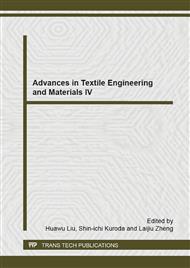p.236
p.240
p.245
p.250
p.254
p.259
p.264
p.268
p.272
The Relationship of Subject Evaluation Factors on the Elastic Trousers
Abstract:
In this study, eight different elastic knitted fabrics were chosen to make eight tight trousers of the same style and same size, and ten female students at Shanghai University of Engineering Science were chosen to try on these trousers. In the subjective experiment, 5 levels quantitative evaluation methods were adopted which the sensory characteristics was divided into 5 grades. On three kind of continuous state, each wearer was asked to evaluate on the stretch pants separately. By analyzing the subjective data, we can make a conclusion that the clothing pressure comfort and the sense of restraint are related not only to clothing pressure, but also to some other physiological and psychological feeling of wearer.
Info:
Periodical:
Pages:
254-258
Citation:
Online since:
October 2014
Price:
Сopyright:
© 2014 Trans Tech Publications Ltd. All Rights Reserved
Share:
Citation:


